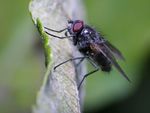Difference between revisions of "Musca spp."
Jump to navigation
Jump to search
(i) |
|||
| Line 25: | Line 25: | ||
=='''Musca autumnalis'''== | =='''Musca autumnalis'''== | ||
| + | {| cellpadding="10" cellspacing="0" border="1" | ||
| + | | Also known as: | ||
| + | | '''Face Fly | ||
| + | |- | ||
| + | |} | ||
| + | ==Identification== | ||
| + | The fly is around 7-8mm in length. It grey in colour and has 4 dark stripes on the thorax. It is very similar in appearance to ''M. domestica'', and has prominant red eyes. | ||
| + | ==Life Cycle== | ||
| + | ''M. autumnalis'' feeds on secretions from the nose, mouth, and the eyes, as well as blood from the wounds left by other flies. It lays eggs in cattle manure, which later develop into larvae. The larvae pass through three seperate stages, before forming pupae in the soil. Under optimal conditions, they require around 2 weeks to complete the life cycle. | ||
| + | |||
*Also known as 'house' and 'face' flies | *Also known as 'house' and 'face' flies | ||
Revision as of 21:07, 16 July 2010
Scientific Classification
| Kingdom | Animalia |
| Phylum | Arthropoda |
| Class | Insecta |
| Order | Diptera |
| Family | Muscidae |
| Genus | Musca |
Musca autumnalis
| Also known as: | Face Fly |
Identification
The fly is around 7-8mm in length. It grey in colour and has 4 dark stripes on the thorax. It is very similar in appearance to M. domestica, and has prominant red eyes.
Life Cycle
M. autumnalis feeds on secretions from the nose, mouth, and the eyes, as well as blood from the wounds left by other flies. It lays eggs in cattle manure, which later develop into larvae. The larvae pass through three seperate stages, before forming pupae in the soil. Under optimal conditions, they require around 2 weeks to complete the life cycle.
- Also known as 'house' and 'face' flies
- Includes Musca domestica the house fly and Musca autumnalis the face fly
- Found in temperate regions
- The house fly is present both inside and outside of buildings
- The face fly is one of the most numerous flies which annoy cattle
- Attracted to the head and upper parts of the body
Recognition
- 7.5mm long
- Sponge-like labellum mouthparts
- Grey thorax with longitudinal stripes
- Yellow abdomen with a single black stripe
Life Cycle
- Eggs laid in rotting manure, hatch and pass through pupal and larval stages before emerging
- Eggs hatch within 12 hours of being deposited
- Life cycle takes 12 days
- Flies may overwinter as adults
Pathogenesis
- Production losses
- Reduced weight gain
- Reduced milk yield
- Fly worry
- Disease transmission
- Viruses
- E.g. Coxsackie, enteroviruses, poliomyelitis
- Bacteria
- Helminths
- E.g. Intermediate hosts for Habronema in horses, some poultry tapeworms, Parafiliaria and Thelazia in cattle
- Viruses
- Feeds on secretions from the eyes, nose and mouth as well as blood left in wounds by other flies
Control
- Fly control in breeding and resting sites (to reduce the source)
- Breeding sites
- Good sanitation
- Collect dung in heaps
- Spray surface of heaps with insecticide to kill surviving adults and larvae
- Biological control
- Resting sites
- Spray inside and outsides of buildings with insecticide
- Breeding sites
- Fly control on the host
- Wide range of products available
- Nil or short withdrawal period needed for milking animals or animals going for slaughter
